MARIANI’S
Virtual
Gourmet
July 24, 2022
NEWSLETTER
Founded in 1996
ARCHIVE
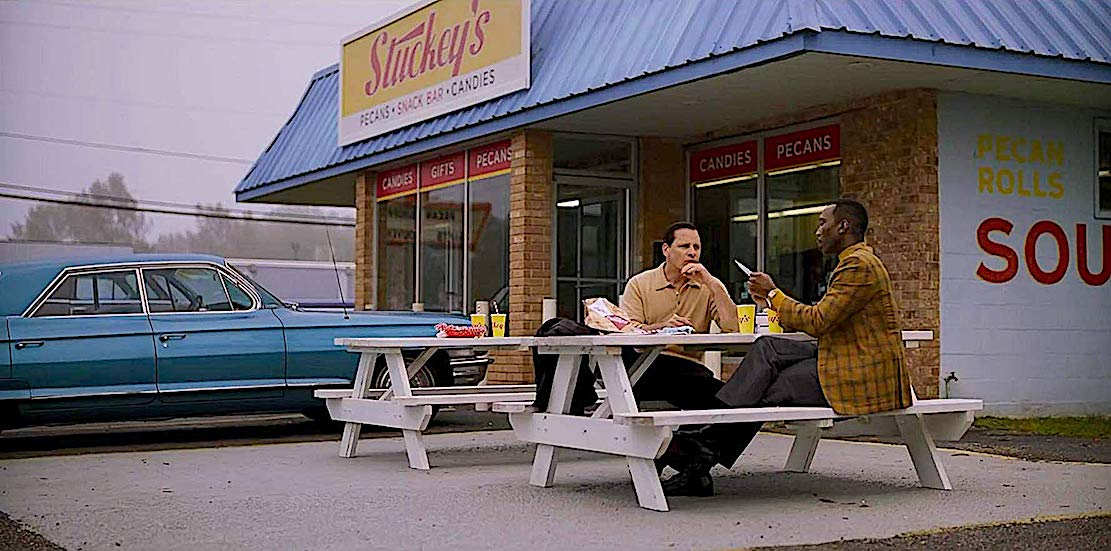
Vigo Mortensen and Mahershala Ali in "Green Book" (2018)
IN THIS ISSUE
HOW SUSTAINABILITY HAS BECOME A
REQUISITE IN THE HOTEL INDUSTRY
By John Mariani
NEW YORK CORNER
SEA FIRE GRILL
By John Mariani
ANOTHER VERMEER
CHAPTER 29
By John Mariani
NOTES FROM THE WINE CELLAR
ITALIAN REDS FOR SUMMER
By Geoff Kalish
❖❖❖
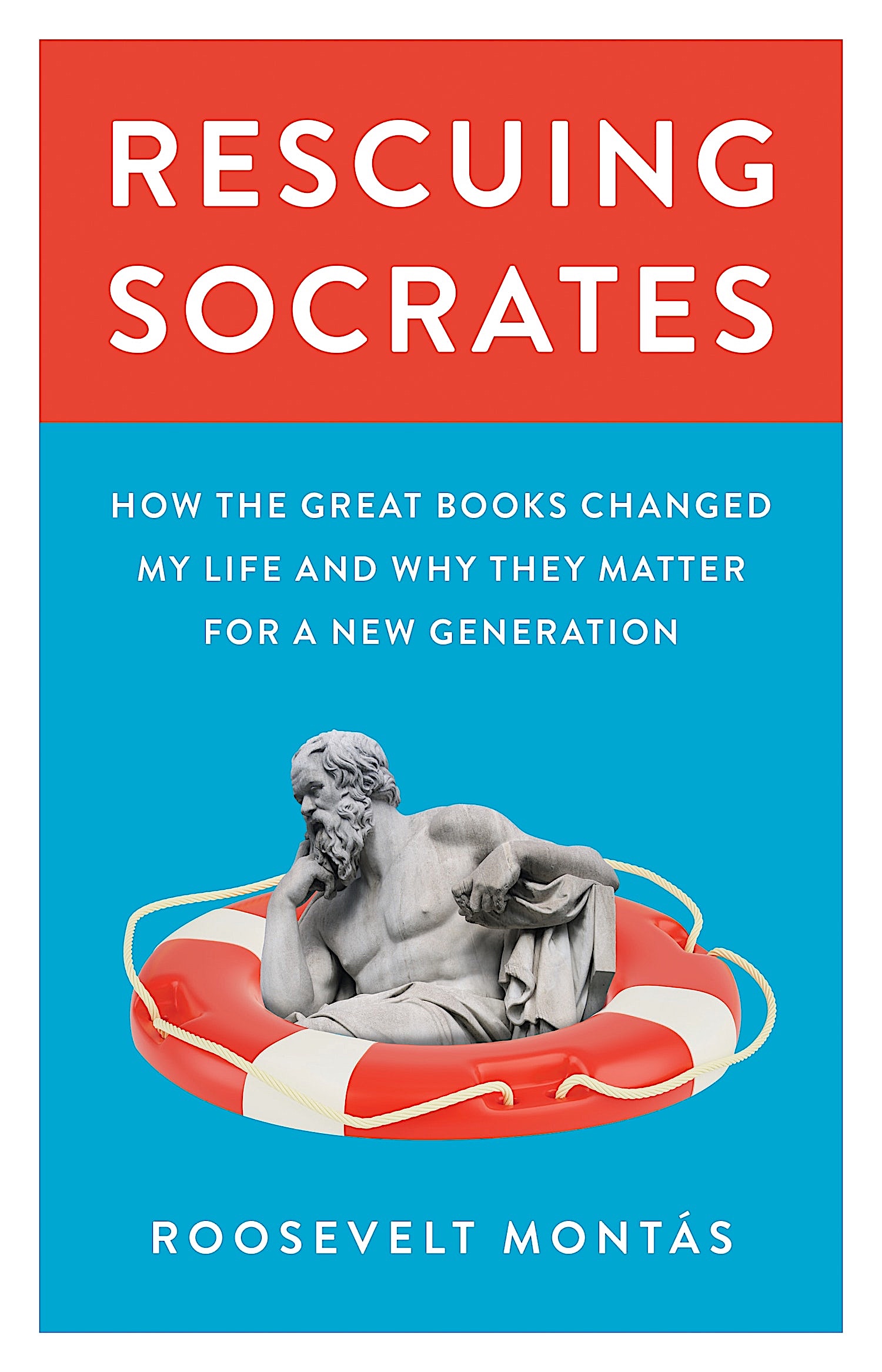 author
of Rescuing Socrates:
WVOX.com.
The episode will also be archived at: almostgolden.
author
of Rescuing Socrates:
WVOX.com.
The episode will also be archived at: almostgolden.
❖❖❖
HOW SUSTAINABILITY HAS BECOME A
REQUISITE IN THE HOTEL INDUSTRY
By John Mariani
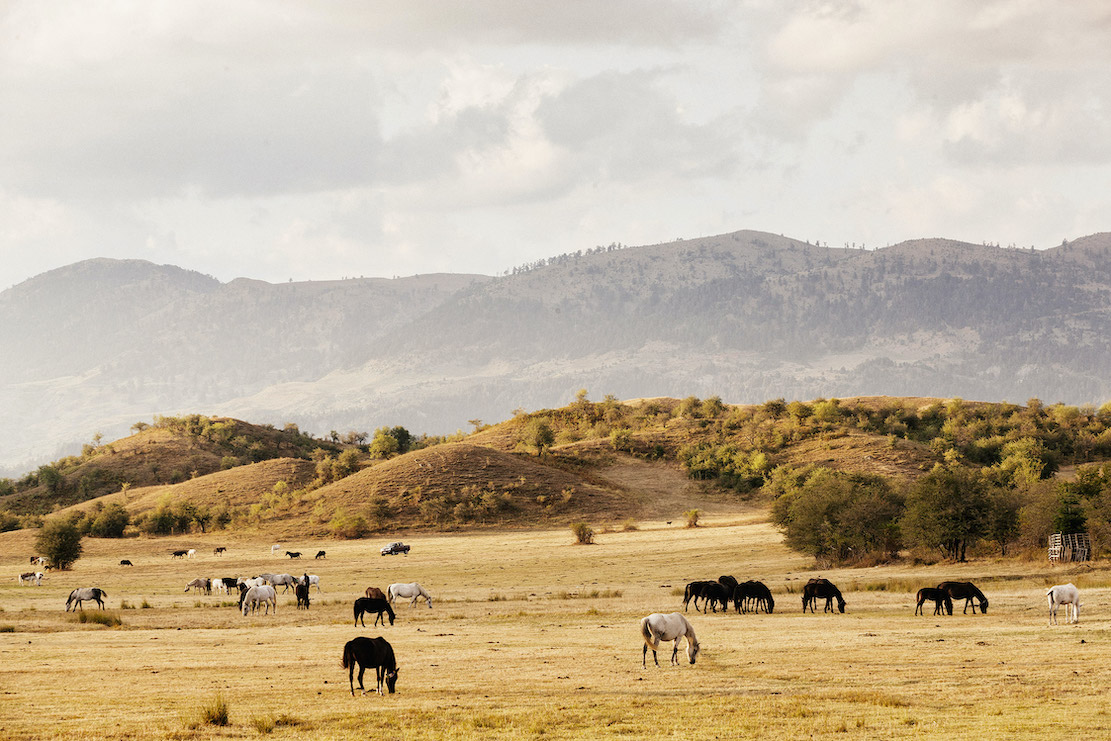
The requisite amenities of luxury hotels has long been focused on the room—free WiFi, linens with high thread counts, widescreen HD TV and premium liquors in the minibar. Now, however, hotels have engaged more than ever in sustainable practices, not only to save themselves the effects and cost of climate change, but because their clientele are demanding it. How this has developed into a marketing necessity was the subject of my interview with Daniel Luddington, VP Development, Small Luxury Hotels of the World, which has introduced its new Considerate Collection line.
 What
are the elements of
“sustainability” in the new collection?
What
are the elements of
“sustainability” in the new collection?To select and showcase the very best sustainable hotels within Small Luxury Hotels of the World, we used the framework of the Global Sustainable Tourism Council, the GSTC. There is a strong relationship between the GSTC Criteria and the UN’s Sustainability Development Goals (SDGs). By uptaking the GSTC Criteria, our hotels are helping to meet the UN SDGs. Economic, environmental and societal dimensions are all addressed. So, Considerate Collection hotels must demonstrate high alignment across 3 pillars of sustainability:
First, environment: We are seeking hotels that nurture nature, that maximize their positive impact to the environment. Environmentally conscious hoteliers must be passionate, not just minimizing negative impacts, reducing energy, water, waste and carbon, but also they must demonstrate positive regenerative impact (switching to green energy, organic farming, biodynamic gardens, conservation, rewilding and reforesting). EarthCheck Silver-certified Amilla Maldives is doing this well with an ongoing coral propagation project and a Long Tail Tropic Bird breeding program, complimentary bicycles, electric golf buggies, and an outdoor zero power gym.
Next, hotels must be Cultural Custodians working tirelessly to protect, preserve and promote their cultural heritage for generations to come. Elements of local culture must be woven throughout the operation and the guest experience as well as the design, decoration, staff uniforms and, of course, the cuisine. Dar Ahlam in Morocco is a great example with their Memory Road project. Together with the Global Heritage Fund, they’re bringing abandoned villages in southern Morocco back to life, preserving the Berber way of life.
Last but not least, we require our hoteliers to be Community Minded; ideally, the owners are locals. Local ownership means a great deal as they are custodians and likely to care more about the place and its people. Staffing local people in management is important. Hotels must invest in the education, healthcare, and training of their staff and their local families. Local procurement is also key, choosing to buy local food, of course, local fabrics, local furniture, local design, local art and experiences designed and driven by the local community. You will see a great reflection of this pillar at Bhutan Spirit Sanctuary, where almost all of the team are Bhutanese and are closely connected to their home communities.
In the past, what aspects of the industry paid no attention to sustainability and in what ways?

I think our industry is still guilty of promoting frequent flier travel, which flies in the face of sustainable tourism. We should be focusing on making travel count, flying less but staying longer, slowing down, and investing more time in destinations that we know are not suffering from over-tourism and spending more in destinations where our money can go further and will make more of a difference. And this is where local independent hotels are crucial, because there is far more of a chance of the money staying in the destination rather than leaking out of the country to a foreign corporate owner.
Amilla in the Maldives
Is such a commitment more expensive for the properties and industry? Does it add to the consumers’ expenses ?
There’s always an initial financial outlay for any business when setting up new systems; however, sustainable business drives go hand-in-hand with cost efficiencies. Hervé Houdré is one of the sustainable hospitality experts we collaborate with for the Considerate Collection and he puts it perfectly when he talks about encouraging hotels to adopt a business model integrating the Triple Bottom Line of Profit, People and Planet in their strategy.
This model first and foremost starts with profit: When hotels become more efficient with energy use, water consumption and waste management, all of which are the foundation for a clean environment, we realize that hoteliers actually end up saving quite a bit of money, which should trickle down to the guests’ bottom line as well.
Another thing for the industry to bear in mind is that the legislative landscape is evolving globally to meet with climate change targets, therefore it’s important to invest and take action now to avoid fines and reputational damage in the future.
Finally, I think where there are increased costs for guests, it’s important for hoteliers to be transparent and to clearly communicate the added value of their sustainability practices to the environment and community, so that guests can feel part of the solution.
Will there be commitment in the future to eliminating all fossil fuels (except the kitchens) in heating, lighting, etc? Especially given the rise in fuel prices.
Sustainability is very much a journey for all of us and, as mentioned, our criteria for the Considerate Collection is aligned with GSTC and the UN’s SDGs. I suspect there will be more stringent guidelines put in place, especially following the recent report “Fueling Failure” by the Fossil Fuel Non-Proliferation Treaty. The report really exposes the dangers of fossil fuels and how they undermine the SDGs. As the Considerate Collection grows and evolves its criteria, a commitment to reducing fossil fuels within all hotel operations is absolutely one of the immediate goals. Elimination is the ideal destination. While we cannot avoid the creation of pollution via transportation at the current moment, we can, however, offer travelers opportunities to discover sustainable hotels that choose more efficient renewable energy, water and waste management systems.
Has the public been clamoring for this?
Prior to launching the collection, we surveyed over 1,500 members of our loyalty program, and nearly two thirds believe sustainability is more important now than pre-Covid (an increase from 16%), with 58% intending to make more sustainably-minded choices when they travel; yet 57% pointed out how hard it can be to find the information they need to make an informed choice. Over half are wary of hotels making claims that simply aren’t true. This is one of the reasons why we launched the Considerate Collection—as an answer to what forward-thinking travelers have been seeking out.
Our curated collection makes planning stays at sustainable luxury hotels much easier, eliminating tedious research and greenwashing. There is a lot of that going on. My word, every hotel I am seeing launched now is using ‘eco’ in its marketing patter, and funnily enough, they are all being tagged as ‘green’ by OTAs that allow hotels to ‘self-assess.’ This doesn’t help the public because how can they grasp the truth? This is why third-party verification and certification are important in all of this and why Considerate Collection hotels have to demonstrate hotels are walking the walk.
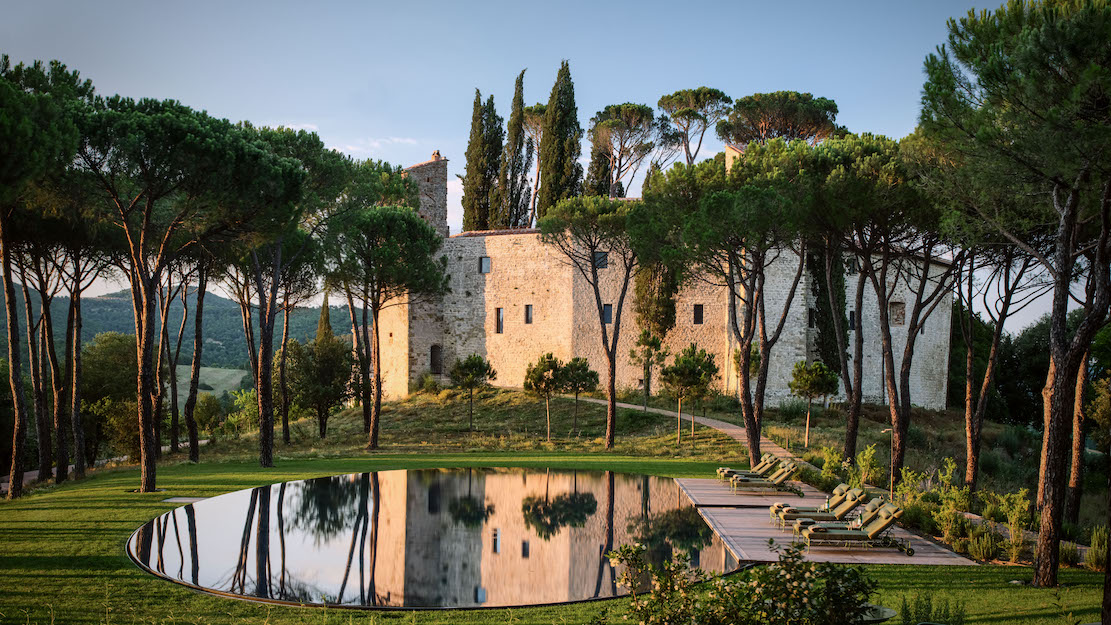 How
has the word
“Luxury” changed in this century?
How
has the word
“Luxury” changed in this century?Once upon a time, “luxury” was a material concept often defined by the biggest, shiniest and most expensive. Over the years, as people have become more discerning, luxury has become more about a state of mind. At its core, though, it's always been about status, but it’s shifted from material possession and is now more about “Who I am.” People want to show that they are more ethical, creative, connected and tasteful than the masses. With growing concerns about our impact on the environment, I think luxury and sustainability are almost interchangeable. For us here at SLH, sustainability is the new luxury.
Interestingly enough, our Considerate Collection hotels that are managed sustainably also score the highest in our mystery inspection reports, which for the most part is measuring the luxury guest experience. Perhaps the people are happier working there; they are cared for, so they are more capable of caring for their guests.
I recently returned from Castello di Reschio in Perugia (above). Achingly beautiful, utterly luxurious, wholly sustainable. They’re implementing heat pump energy, demonstrating zero waste; there are no plastics in sight. The hotel staff is about 90% local employees, and they are doing an amazing job to protect and preserve the old abandoned farmhouses that serve as the guest accommodations.
Luxury is not and cannot be this wasteful excess with this nonsense of constantly replenishing stuff with new stuff, like linen and towels changed every day; having soap changed every time you wash your hands; having one hundred bathroom amenities, slippers wrapped in plastic, the fruit basket wrapped in plastic that nobody eats, the list goes on and on.
We have to acknowledge the hypocrisy of this luxury. We can’t have our own private luxury in big shiny new-build resorts without depriving others in some way of their land, their resources. It’s an inconvenient and uncomfortable truth. Bigger, faster, shinier, warmer, cooler means more steel, more cement, concrete, more plastic, more AC, more diesel and gas, more water. More, more, more. This luxury is unsustainable. Why do we pander to it? When you have 200 rooms, local people are usually not in positions of responsibility, organization and management. On the flip side, if you are a property consisting of several small houses, you can have several small teams in charge and they can be local people. Small is the only way I see luxury.
Tell me about how the hotel industry is rebounding at a time when Covid still lurks and even re-appears?
Everywhere you look, the headline “Travel’s Great Comeback” is in full effect, even though Covid still exists. Vaccination and breakthrough medications paired with a general sentiment for the population to simply move on means that people are increasingly hungry for travel, almost inarguably, now more than ever. Our current brand campaign, Transcend Your Travel Comfort Zone, speaks to this sentiment. We ran a survey that highlighted that people have been stuck in a “comfort zone” of fears, anxieties and uncertainties, naturally, because of the last two years, and for 64% of people, travel is the top-ranking means to help them step out of their comfort zone. Some of our hotels are experiencing their best season ever coming out of the pandemic because people are ready to move on and live with Covid. Hotels have had time to pause, reflect and refine their offerings and are ready to receive guests. We’ve seen some really creative concepts, for example the Wittmore Hotel in Barcelona is offering a “sleep beneath the stars” experience from May-October, where guests can exclusively book and sleep on the rooftop overnight.
❖❖❖
SEA FIRE GRILL
158 East
48th Street
212-935-3785
By John Mariani
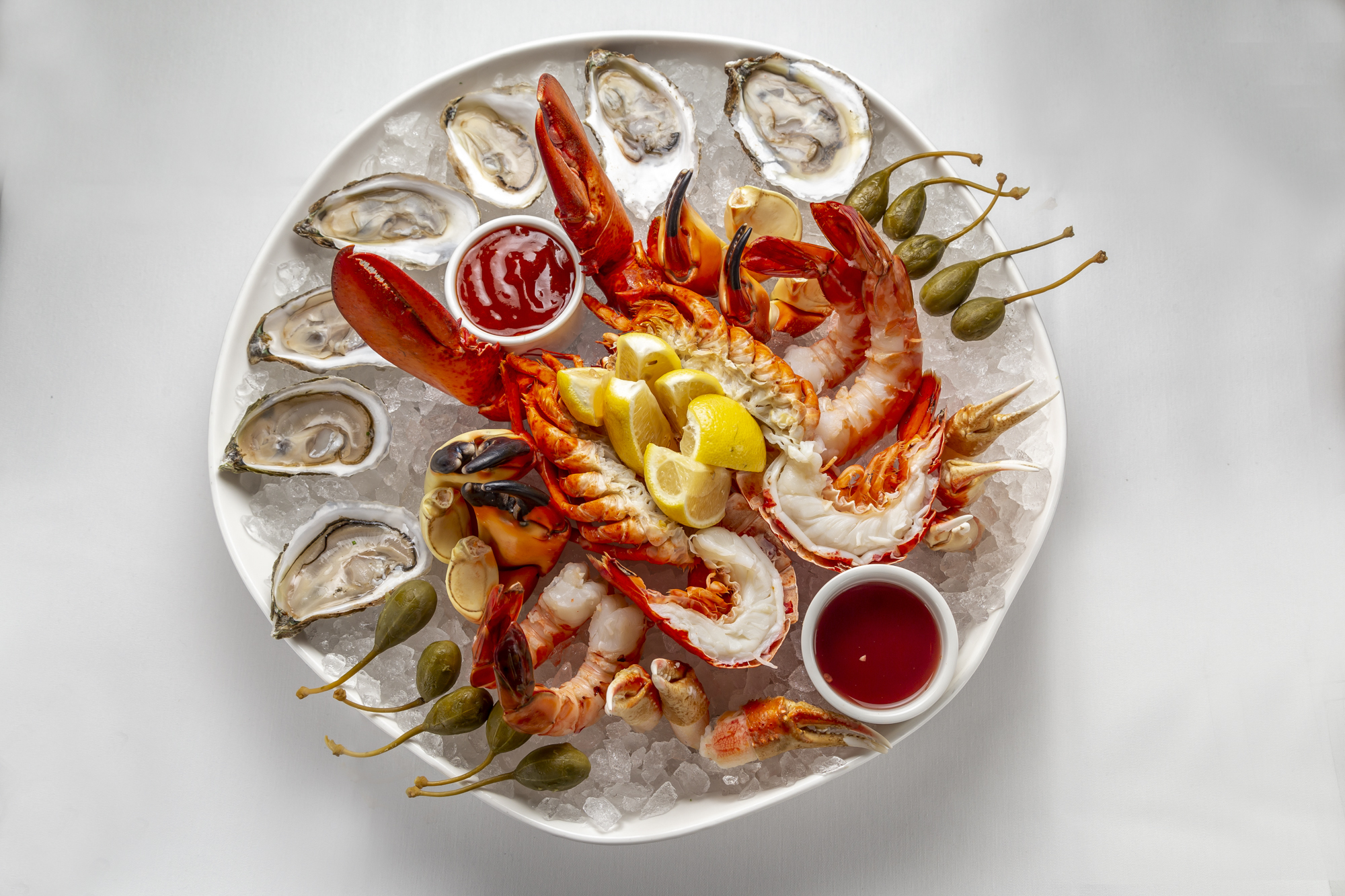
For some reason American seafood restaurants, whether in Oahu, Charleston or Boston, are often called “houses,” which suggests a big boisterous barn-like atmosphere and huge broadside menus. New York had that tradition, too, with creditable old favorites like The Gloucester House, along with a number of “clubs” and “grills,” like the ten-year-old Sea Fire Grill in Midtown.
 Owned
by Benjamin Prelvukaj and Benjamin
Sinanaj (left), the same team that runs
two Benjamin Steakhouses and Benjamin Prime,
Seafire has much the same commitment to
sophisticated dining, civilized décor,
conscientious service and first-rate
ingredients culled by chef Ismael Mendez.
Owned
by Benjamin Prelvukaj and Benjamin
Sinanaj (left), the same team that runs
two Benjamin Steakhouses and Benjamin Prime,
Seafire has much the same commitment to
sophisticated dining, civilized décor,
conscientious service and first-rate
ingredients culled by chef Ismael Mendez.When I entered Sea Fire Grill, down three steps, I had the same feeling I always have when I immediately recognize a civilized bar and dining room. From the lighting to the well-spaced, impeccably set tables and conversational sound level, I knew I would be basking as well as dining in surroundings conducive to an evening of good food and conviviality. That was immediately apparent from the greeting at the door to the amiable service of long-time pros in the dining room, including manager and sommelier Jay Dozza and G-M Alex Begolli. The 750-label wine list is
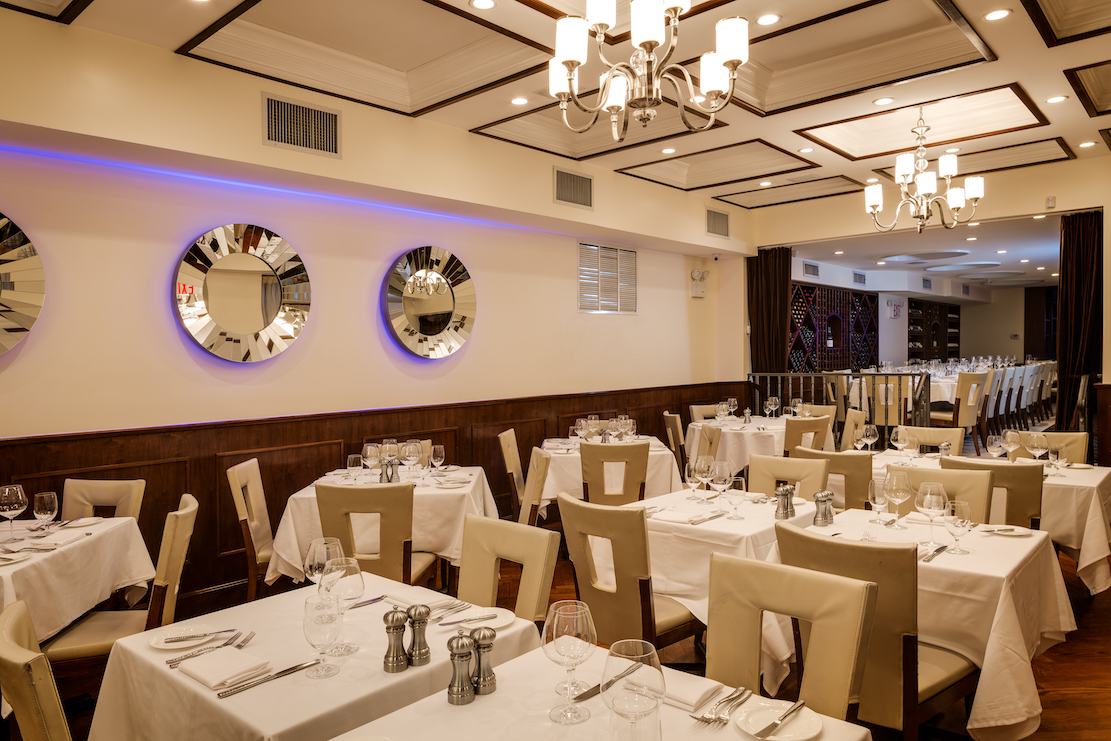 excellent,
especially
for a seafood-based menu. There is also a
remarkable three-course
lunch at $39.
excellent,
especially
for a seafood-based menu. There is also a
remarkable three-course
lunch at $39.
At dinner, à la carte, you may begin with a daily selection of East and West Coast oysters with a peppercorn mignonette cocktail sauce (a sampler is $39), or either a bountiful colossal shrimp or jumbo crabmeat cocktail ($34). Tuna tartare ($27) was pristinely fresh and delicious, made from yellowfin with a citrus crème fraȋche, and the jumbo lump crabcake (a bargain at $29) was moist and loosely packed with an enhancement of red pepper coulis, tartar sauce, celery root remoulade and frisée salad that show a real generosity of spirit. The night’s special was softshell crabs (MP), big meaty ones, sauteed to retain their tenderness with a slight crunch upon biting. Tender, too, was the velvety grilled octopus with a thicket of onions, peppers and capers dressed with virgin olive oil ($26).
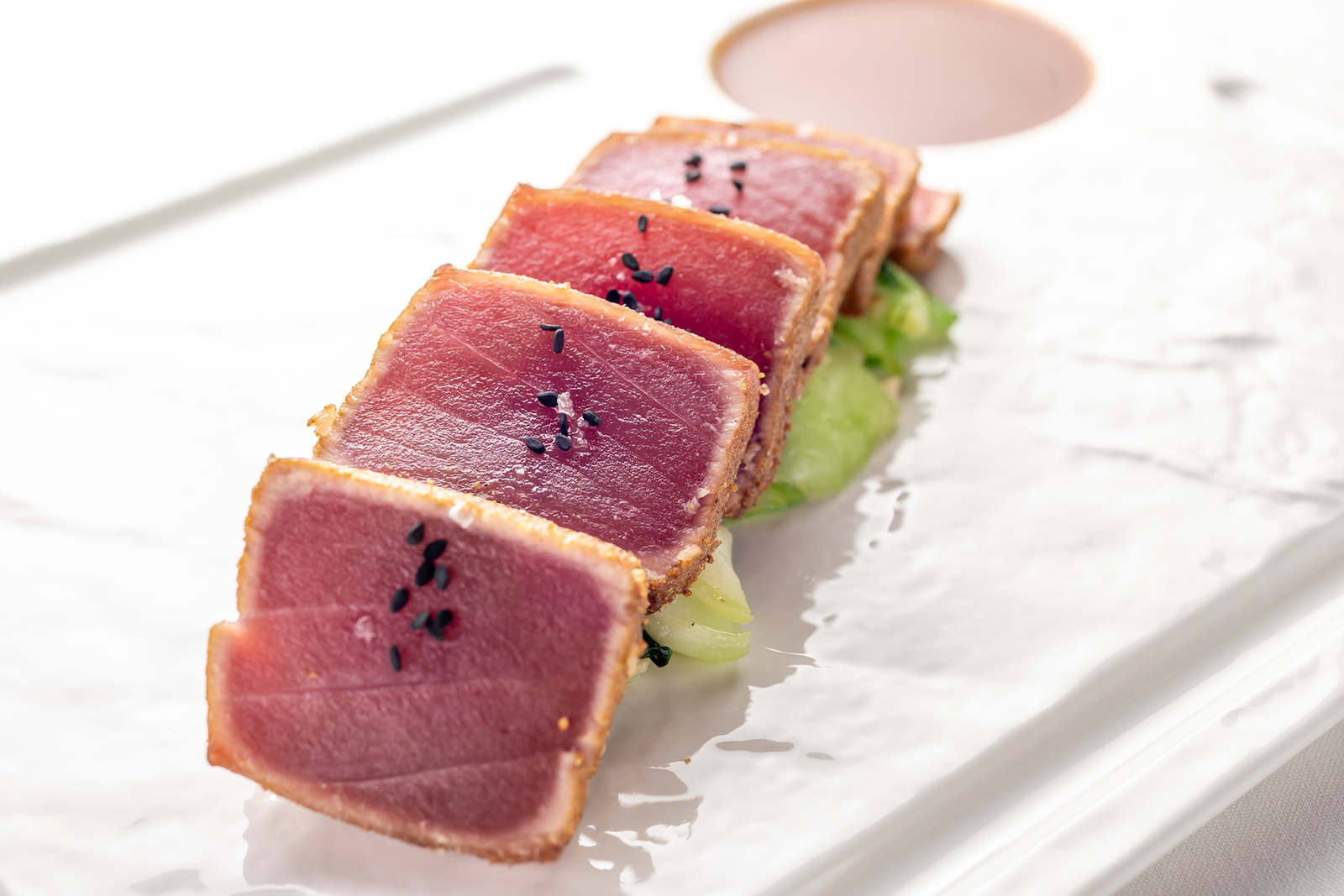 We had a middle course of trofie pasta
with a lush mushroom and black truffle cream
($40 as an app; $80 as a main
course).
We had a middle course of trofie pasta
with a lush mushroom and black truffle cream
($40 as an app; $80 as a main
course). Sea Fire has a caviar section ($95-$125), but, as everywhere else, these fish roe are not from the Caspian Sea, though taking the moniker “Kaviari.” I’ll pass.
Chef Mendez makes a point of serving sustainable and seasonal seafood, and right now the lobsters (MP) are sweet and fat, weighing in at a hearty two pounds and stuffed with crab meat, if desired, and clarified butter. A properly good thick swordfish ($49), caught off Montauk, was as juicy as the best I’ve had, subtly blackened with seasonings and served with tartar sauce and the novelty of avocado mousse.
Mahi-Mahi (right) hasn’t been showing up on menus in New York recently, but it’s a fine fish, and Mendez prepares it with a deft hand, roasting the filet and siding it with a tomato risotto and surrounding it with a red wine-tomato reduction ($59). Tuna ($54), cooked rosy red (above), came with steamed bok choy, mustard greens and sesame-soy vinaigrette. Note that the accompanying vegetables are not the usual broccoli-cauliflower-carrots so many places scoop out of a pan onto the plate. At Seafire the vegetables are chosen to complement the main protein.
For those who would choose to dine at Sea Fire Grill and not order seafood, the steaks and chops come from the same meat lockers as at their Benjamin restaurants.
One dessert will feed four people but two desserts will make everyone very giddy. Go for the chocolate soufflé topped with vanilla ice cream ($15); crispy bourbon pecan pie with vanilla ice cream; a finely textured New York cheesecake ($12); crème brûlée ($12); tiramisù ($12); or a creamy Key lime pie ($12)—all served with a big dollop of whipped cream, of course.
Eating out is not the same thing as dining out, and for anyone who needs a lesson in the differences, Seafire Grill is an eminent place to begin.
❖❖❖
ANOTHER VERMEER


“The date and place of the auction will be set this week,” said the caller. “So proceed with the current plans unless you hear otherwise from me.”
“It appears the media have been picking up on the story, now that the actual auction is coming up,” said the other voice. “But the principal auction houses have stopped all comment.”
“That should work in our favor. There will be an element of mystery.”
“Is there anything else you need me to do here?”
“Not at this time. I will tell you all you need to know and nothing more.”
After Labor Day the new arts season began in New York, and museums, theaters, ballet, jazz clubs, cabarets, and every other venue of the arts mounted their best productions, just as the movie studios brought out their “serious” movies for Oscar consideration after the barrage of summer blockbuster sci-fi movies.
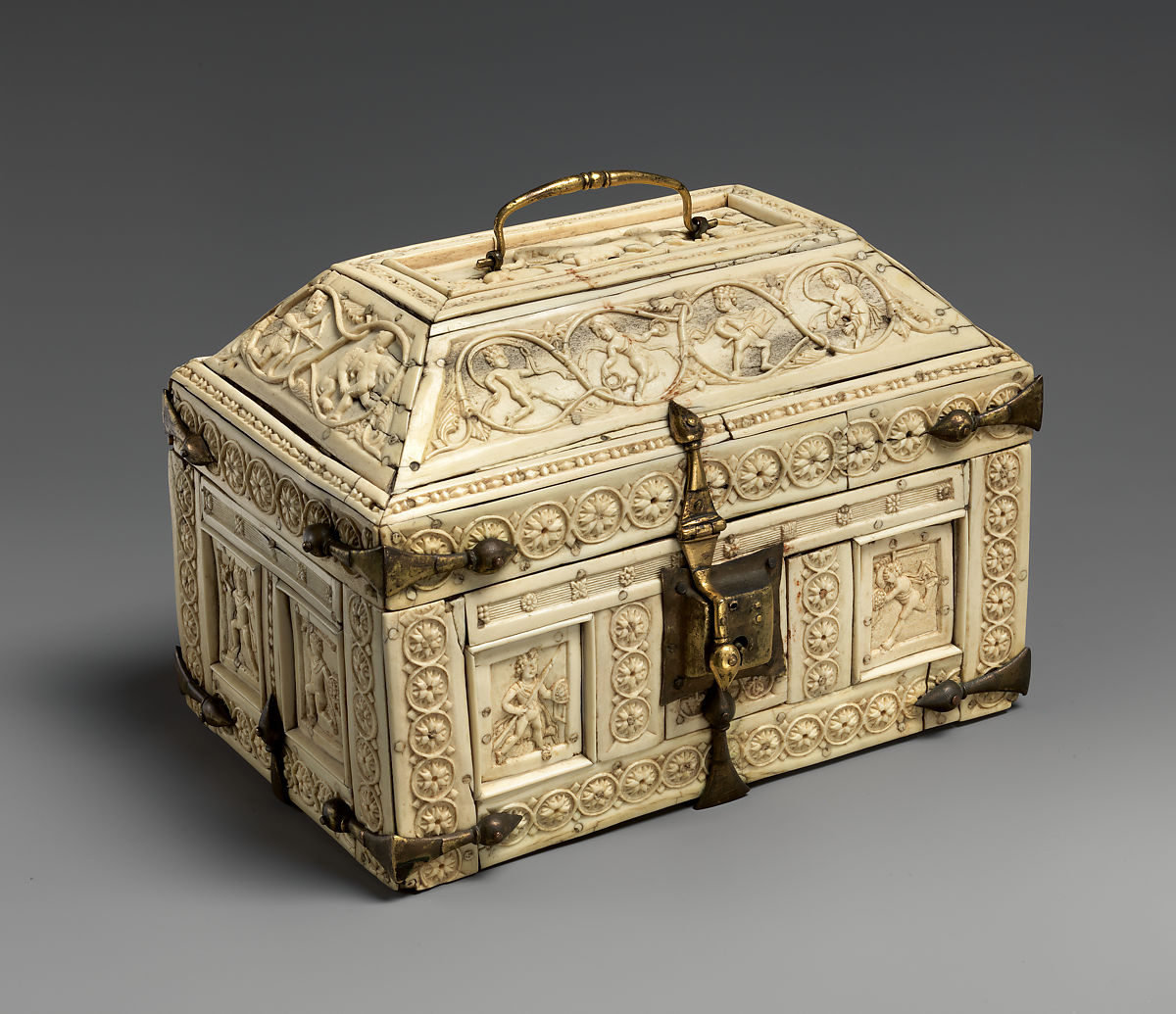 The
Metropolitan Museum of Art presented a spectacular
“Glories of Byzantium” exhibit (left) ,
there was a Gianni Versace show, and a major
Paul Klee retrospective; the Museum of Modern Art
debuted a controversial Egon
Schiele exhibition; and the Guggenheim had major
shows on modern masters Robert
Rauschenberg and Stuart Davis (below).
The
Metropolitan Museum of Art presented a spectacular
“Glories of Byzantium” exhibit (left) ,
there was a Gianni Versace show, and a major
Paul Klee retrospective; the Museum of Modern Art
debuted a controversial Egon
Schiele exhibition; and the Guggenheim had major
shows on modern masters Robert
Rauschenberg and Stuart Davis (below). Autumn was when the auction houses brought out the works they believed would bring the most money, sometimes holding back a work for a year rather than sell it in the spring or the summer, when sales were dead.
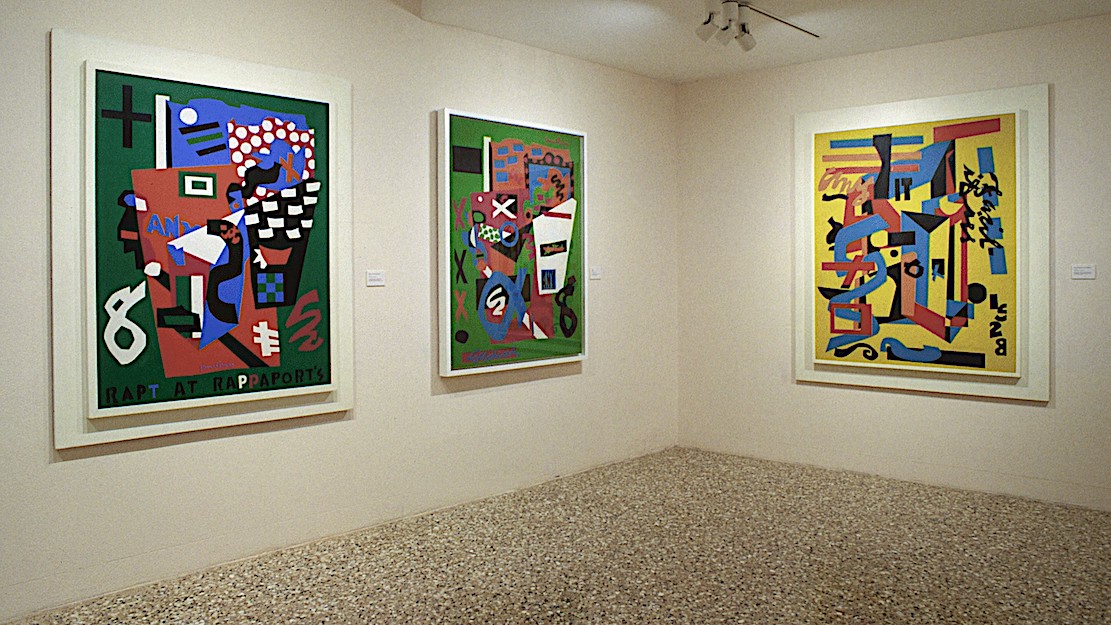
So the Vermeer sale was considered one of the major events of the auction season. The mystery of which auction house would put it up, and how well authenticated the painting would be, was the talk of countless parties in every art capital of the world. Catalogs, usually written months in advance, could not include the Vermeer; a brochure would have to do.
Katie had kept herself busy interviewing anyone she thought would give her a good quote for her story—curators, Vermeer experts, auction house personnel, even people who were merely visiting such institutions—to ask if they knew about the Vermeer sale and what they thought if they did.
The more people she interviewed the more she realized how adversarial the art world was and how business and profit trumped all other concerns. Time and again she was told that the moment a great master’s work was tossed from his CR, its value plummeted. And, if a painting was suddenly declared to be by a master—even a work that had been hanging in a museum for decades or stored away in its inventory—its value would soar. Paintings once considered of poor quality suddenly became masterpieces when attributed to a favored artist of the moment. This was all very big business, requiring tact, erudition and fiscal caution. The fall art auctions in New York were not “Antiques Roadshow.”
 There
were always those curators who would work, even
beg,
for years to garner support from rich patrons to
buy a work that filled a void,
perhaps a minor piece that nevertheless was a link
between one period or another,
something from Picasso’s Rose Period (left),
perhaps, or a work in bronze that was the
first of its kind in a century before Christ, or
maybe a Medieval painting by
Duccio that for the first time in western history
showed a landscape outside of a
window (below).
There
were always those curators who would work, even
beg,
for years to garner support from rich patrons to
buy a work that filled a void,
perhaps a minor piece that nevertheless was a link
between one period or another,
something from Picasso’s Rose Period (left),
perhaps, or a work in bronze that was the
first of its kind in a century before Christ, or
maybe a Medieval painting by
Duccio that for the first time in western history
showed a landscape outside of a
window (below). But those same museums and galleries and auction houses were also happy to acquire or sell works that had quite dubious provenance—more often than not, an ancient work too perfect to be true, suggesting it was created to spark all the right reactions and fool the experts. Such works might reside in the most favored rooms in museums—shown off as among the museum’s finest works—only to prove a forgery and be removed ignominiously after the press had its field day
 of mocking
the experts.
of mocking
the experts. Days went by when Katie and David did not speak, both confident the other was making slow progress on what would be a solid story. As a journalist, Katie saw everything unfolding with enough unsavory characters and finaglers to expose the underbelly of the art world. If a crime was committed, so much the better.
David, on the other hand, found only the prospects of criminality of real interest, since he really didn’t care what the esoteric machinations of the art world involved. The funny thing was that he had come to see the distinctions between the mobsters he’d investigated while he was a cop and the crooks in the art world. He’d come to realize that while the mobsters had no taste whatsoever when it came to art, they had enormous sums of money to spend on cars, homes in the Bahamas and Vegas, and the garish décor they favored, like gold bathroom fixtures and gilded nude statuary around the pool.
It would never occur to any of them to go out and bid on a work by an artist whose names they’d never even heard of, like Giacometti, de Kooning, or Warhol. A poor copy of da Vinci’s “Last Supper” hung above the sofa, or a piece of erotic sculpture a mob wife picked up for a couple of grand at a gallery that had for years been “GOING OUT OF BUSINESS” on Central Park South, was fine with them.
On the other hand, the fine arts people fought over works of art either for simple investment or for bragging rights. One might specialize in pre-Raphaelite art, because composer Andrew Lloyd Webber (below) was collecting it, or contemporary photography, because rock star Elton John was building a formidable collection. Another might buy work guided by a consultant who insisted an artist was about to become a big deal very soon. Others in that world simply loved being involved with the social whirl of exhibition openings and charity galas, showing off their gowns and copies of their jewels.
It all seemed to David that so little of it had to do with the true excellence of the work of art, rather than the price of everything out there. Money drives everything. As usual.
Most of the mainstream U.S. newspapers, like The New York Times and The Washington Post, had not really covered the Vermeer story since it broke because they had nothing much to report on beyond who they thought would be probable bidders, which included a few on the list David had gotten from Gerald Kiley.
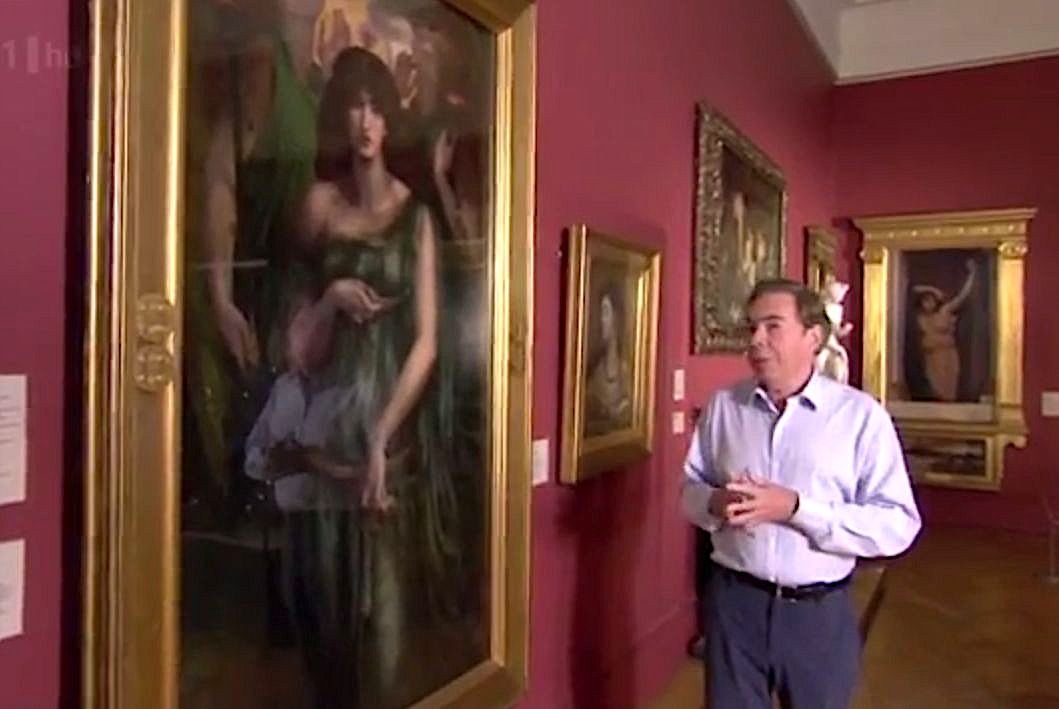 Purely as a news story, the New York papers
covered the
hit-and-run incident that put Robert Lauden in the
hospital, referring to him
as the wealthy scion of the Lavande cosmetics
family, philanthropist and art
collector. Both the Times and
the Daily
News tried to find out more about
the Chinese delegate involved but were stonewalled
by the Embassy, leading the News to
publish a raging editorial
against the abuse of diplomatic immunity. The
Wall Street Journal did a weekend story
mainly about the money that would
be involved in the sale and how no museum in the
world, not even the Getty,
could afford to spend its resources and endowments
on a single $100 million
work of art.
Purely as a news story, the New York papers
covered the
hit-and-run incident that put Robert Lauden in the
hospital, referring to him
as the wealthy scion of the Lavande cosmetics
family, philanthropist and art
collector. Both the Times and
the Daily
News tried to find out more about
the Chinese delegate involved but were stonewalled
by the Embassy, leading the News to
publish a raging editorial
against the abuse of diplomatic immunity. The
Wall Street Journal did a weekend story
mainly about the money that would
be involved in the sale and how no museum in the
world, not even the Getty,
could afford to spend its resources and endowments
on a single $100 million
work of art.Not surprisingly, The Times of London, which covered the art world more thoroughly than its American counterparts, had done several stories speculating early on about where the painting had been for more than 300 years, then, when it was announced in Art Today that the painting was being sold by the People’s Republic of China, the Times’s Hong Kong bureau began questioning every source it could dig up to find out more. Not much came of those inquiries, except rumors that ranged from the possible to the ridiculous.
One source insisted the Chinese, without mention of the connection to alchemy in the painting, were selling the Vermeer for gold and would refuse to take U.S. dollars, pounds Sterling or Euros. The story told how almost all China’s gold reserves had been shipped to Taiwan after the revolution began, not only from banks but literally stripped from people’s fingers and wrists. As a result, the People’s Republic of China authorities tried any way they could to rebuild their gold reserves, so that even during periods of starvation under Mao Zedong, grain was being sold abroad for gold.
Another Times story said the sale was to test the water for China’s entry into the world art market with something spectacular, and that, if the Vermeer sold for what it was expected to, they would bring more masterpieces—heretofore unknown—to auction. The source on that story even suggested the Chinese had a da Vinci painting, which would join only fifteen known to exist in the world.
Other rumors spread that the painting was either a forgery commissioned by the Chinese, or one done to fool the Chinese and the world market. There were even suggestions of known forgers who might be behind such a ploy. One expert in such matters went so far as to say the Chinese had squads of painters ready to turn out Old Master paintings if the Vermeer sale went as well as was expected.
Katie had been following the Times’s coverage, relieved that no one had made the connection to the Shui family in Taiwan. Since it was not something she could prove, and since she didn’t write for a daily newspaper, she was not offering up that part of her story.
© John Mariani, 2016
❖❖❖
ITALIAN
REDS FOR SUMMER

By Geoff Kalish
Because of their higher alcohol content and full-bodied flavor, many consumers find Italian red wines like Amarones, young Brunellos and Barolos too robust to enjoy with most summertime fare. On the other hand, during the past few weeks I’ve enjoyed a number of Italian reds that match most of my warm weather favorite foods quite well. The following discusses some sensibly priced choices.
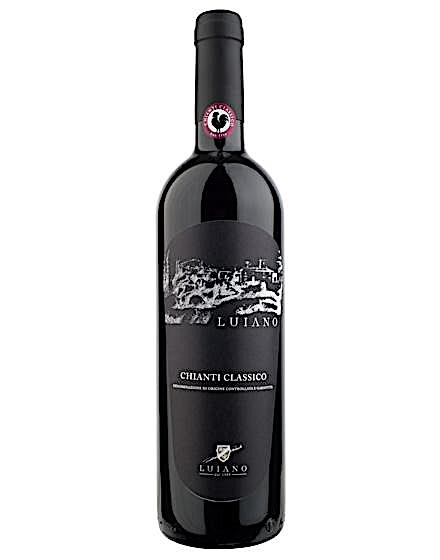 Topping the list are two
Tuscan gems,
both of which mated perfectly with grilled chicken as
well as strip steak and
hamburgers. The 2019 Castello di
Volpaia
Chianti Classico ($25) has an easy drinking
medium-bodied taste of ripe
cherries and strawberries with hints of mint in its
finish. It’s made from a
blend of 90% Sangiovese and 10% Merlot grown on
southern-facing hillside
vineyards just north of the town of Radda.
Fashioned from a blend of primarily Sangiovese
plus small amounts of
Cabernet Sauvignon and Merlot, the 2019 Fattorie
di Luiano Chianti Classico ($21) is a bit bolder
than the Volpaia, but no
less smooth in its cherry-scented finish.
Topping the list are two
Tuscan gems,
both of which mated perfectly with grilled chicken as
well as strip steak and
hamburgers. The 2019 Castello di
Volpaia
Chianti Classico ($25) has an easy drinking
medium-bodied taste of ripe
cherries and strawberries with hints of mint in its
finish. It’s made from a
blend of 90% Sangiovese and 10% Merlot grown on
southern-facing hillside
vineyards just north of the town of Radda.
Fashioned from a blend of primarily Sangiovese
plus small amounts of
Cabernet Sauvignon and Merlot, the 2019 Fattorie
di Luiano Chianti Classico ($21) is a bit bolder
than the Volpaia, but no
less smooth in its cherry-scented finish.Not surprisingly, many Valpolicella Ripassos from the Veneto area (in the north of Italy stretching roughly from Verona to Venice) are too high in alcohol and full-bodied to enjoy in hot weather. However, we found two made from the classic blend of Corvina, Molinara and Rodinella (by the traditional method of “passing” the wine over the wasted dried grape skins used to produce Amarone) light-bodied enough to match grilled veal as well as pork chops and even grilled skewers of swordfish and shrimp. One was the 2018 Le Preare Ripasso
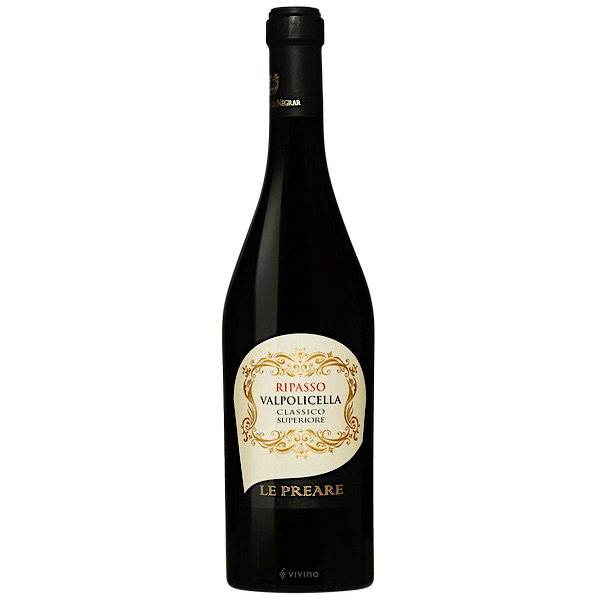 Valpolicella
Classico Superiore ($16), made from
hand-harvested grapes,
fermented and aged in stainless steel tanks, which had
a rather light body and
taste not dissimilar to a southern Burgundy with long
lasting cherry and
raspberry flavors with undertones of herbs de
Provence. The other was a 2018 Masi Campofiorin
Rosso di Veronese
($19), which showed a bouquet and taste of ripe
cherries and black currants
with notes of vanilla in its finish.
Valpolicella
Classico Superiore ($16), made from
hand-harvested grapes,
fermented and aged in stainless steel tanks, which had
a rather light body and
taste not dissimilar to a southern Burgundy with long
lasting cherry and
raspberry flavors with undertones of herbs de
Provence. The other was a 2018 Masi Campofiorin
Rosso di Veronese
($19), which showed a bouquet and taste of ripe
cherries and black currants
with notes of vanilla in its finish. And three bottles from Sicily that we have enjoyed with our warm weather fare spanned the island. From the eastern area around Mount Etna came a wonderful bottle of 2018 Fatorrie Romeo del Castello Allegecore Etna Rosso ($32) made from a blend of Nerello Mascalese and Nerello Caputo grapes that were organically grown in soil rich in volcanic ash. It had a bouquet and smokey taste of blackberries and strawberries with a smooth, memorable finish and married harmoniously with barbecued ribs, chicken wings and even shrimp scampi. Hailing from the Marsala area in the northwestern Trapani Provence, a 2020 Caruso & Minini Terre di Guimara Frappato-Nerello Mascalese ($14) proved to be a winner with lamb chops, showing complex flavors of ripe berries with hints of earthy mushrooms in its finish. Also coming from western Sicily, but well south of Marsala, was an enjoyable 2019 Cos Cerasuolo di Vittoria ($29) made from a blend of organically grown Nero d’Avola and Frappato grapes, fermented in concrete tanks and aged in Slavonian oak for a over a year before bottling. It showed a bouquet and taste of cherries, vanilla and notes of toasty oak in its finish that made a good match for grilled steaks as well as soft mild cheeses like Brie and other triple crèmes.

Dr. Geoff Kalish writes about wine for several publications. He lives in Mount Kisco, NY.
❖❖❖
Any of John Mariani's books below may be ordered from amazon.com.
 OR YOU COULD JUST THROW IT OUT
OR YOU COULD JUST THROW IT OUT
“The Easiest Way to Improve a
Slice of Mediocre Pizza” By Dayna Evans, Eater.com
(6/21/22)
❖❖❖
 The Hound in Heaven
(21st Century Lion Books) is a novella, and
for anyone who loves dogs, Christmas, romance,
inspiration, even the supernatural, I hope you'll find
this to be a treasured favorite. The story
concerns how, after a New England teacher, his wife and
their two daughters adopt a stray puppy found in their
barn in northern Maine, their lives seem full of promise.
But when tragedy strikes, their wonderful dog Lazarus and
the spirit of Christmas are the only things that may bring
his master back from the edge of despair.
The Hound in Heaven
(21st Century Lion Books) is a novella, and
for anyone who loves dogs, Christmas, romance,
inspiration, even the supernatural, I hope you'll find
this to be a treasured favorite. The story
concerns how, after a New England teacher, his wife and
their two daughters adopt a stray puppy found in their
barn in northern Maine, their lives seem full of promise.
But when tragedy strikes, their wonderful dog Lazarus and
the spirit of Christmas are the only things that may bring
his master back from the edge of despair. WATCH THE VIDEO!
“What a huge surprise turn this story took! I was completely stunned! I truly enjoyed this book and its message.” – Actress Ali MacGraw
“He had me at Page One. The amount of heart, human insight, soul searching, and deft literary strength that John Mariani pours into this airtight novella is vertigo-inducing. Perhaps ‘wow’ would be the best comment.” – James Dalessandro, author of Bohemian Heart and 1906.
“John Mariani’s Hound in Heaven starts with a well-painted portrayal of an American family, along with the requisite dog. A surprise event flips the action of the novel and captures us for a voyage leading to a hopeful and heart-warming message. A page turning, one sitting read, it’s the perfect antidote for the winter and promotion of holiday celebration.” – Ann Pearlman, author of The Christmas Cookie Club and A Gift for my Sister.
“John Mariani’s concise, achingly beautiful novella pulls a literary rabbit out of a hat – a mash-up of the cosmic and the intimate, the tragic and the heart-warming – a Christmas tale for all ages, and all faiths. Read it to your children, read it to yourself… but read it. Early and often. Highly recommended.” – Jay Bonansinga, New York Times bestselling author of Pinkerton’s War, The Sinking of The Eastland, and The Walking Dead: The Road To Woodbury.
“Amazing things happen when you open your heart to an animal. The Hound in Heaven delivers a powerful story of healing that is forged in the spiritual relationship between a man and his best friend. The book brings a message of hope that can enrich our images of family, love, and loss.” – Dr. Barbara Royal, author of The Royal Treatment.
 |
The Encyclopedia of American Food and Drink by John F. Mariani (Bloomsbury USA, $35) Modesty forbids me to praise my own new book, but let me proudly say that it is an extensive revision of the 4th edition that appeared more than a decade ago, before locavores, molecular cuisine, modernist cuisine, the Food Network and so much more, now included. Word origins have been completely updated, as have per capita consumption and production stats. Most important, for the first time since publication in the 1980s, the book includes more than 100 biographies of Americans who have changed the way we cook, eat and drink -- from Fannie Farmer and Julia Child to Robert Mondavi and Thomas Keller. "This book is amazing! It has entries for everything from `abalone' to `zwieback,' plus more than 500 recipes for classic American dishes and drinks."--Devra First, The Boston Globe. "Much needed in any kitchen library."--Bon Appetit. |
"Eating Italian will never be the same after reading John Mariani's entertaining and savory gastronomical history of the cuisine of Italy and how it won over appetites worldwide. . . . This book is such a tasteful narrative that it will literally make you hungry for Italian food and arouse your appetite for gastronomical history."--Don Oldenburg, USA Today. "Italian
restaurants--some good, some glitzy--far
outnumber their French rivals. Many of
these establishments are zestfully described
in How Italian Food Conquered the World, an
entertaining and fact-filled chronicle by
food-and-wine correspondent John F.
Mariani."--Aram Bakshian Jr., Wall Street
Journal.
"Equal parts
history, sociology, gastronomy, and just
plain fun, How Italian Food Conquered the
World tells the captivating and delicious
story of the (let's face it) everybody's
favorite cuisine with clarity, verve and
more than one surprise."--Colman Andrews,
editorial director of The Daily
Meal.com. "A fantastic and fascinating
read, covering everything from the influence
of Venice's spice trade to the impact of
Italian immigrants in America and the
evolution of alta cucina. This book will
serve as a terrific resource to anyone
interested in the real story of Italian
food."--Mary Ann Esposito, host of PBS-TV's
Ciao
Italia. "John Mariani has written the
definitive history of how Italians won their
way into our hearts, minds, and
stomachs. It's a story of pleasure over
pomp and taste over technique."--Danny Meyer,
owner of NYC restaurants Union Square
Cafe, The Modern, and Maialino.
|
 |
 |
 |
 |
 |
 |
 Everett Potter's Travel Report:
Everett Potter's Travel Report: 
 Eating Las
Vegas
Eating Las
Vegas
MARIANI'S VIRTUAL GOURMET
NEWSLETTER is published weekly. Publisher: John Mariani. Editor: Walter Bagley. Contributing Writers: Christopher
Mariani, Misha Mariani, John A. Curtas, Gerry Dawes, Geoff Kalish.
Contributing
Photographer: Galina Dargery. Technical
Advisor: Gerry
McLoughlin.
If you wish to subscribe to this
newsletter, please click here: http://www.johnmariani.com/subscribe/index.html
© copyright John Mariani 2022

